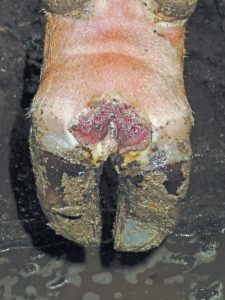Digital Dermatitis – Are you detecting it early enough?
26 October 2020A recent on-line meeting of the Stranraer Sustainable Dairy Group on lameness prevention welcomed vet Dr Sara Pederson to speak about digital dermatitis (DD): risk factors, control and treatment of the disease.
It takes on average 133 days or just over four months for a cow to become visibly lame, from when the treponeme bacteria responsible for DD first comes into contact with the skin. Therefore, if detecting lame cows with DD through manual mobility scoring, you could miss up to 50% of cows that have active lesions, as these cows are not necessarily seen to be lame, even though lesions are present and painful to the touch. Sara said “typically lesions are not detected early enough to be able to return the cow to an uninfected status. The best we can hope for with these animals is to achieve dormant, inactive lesions”.
If DD lesions are not detected and treated early enough with topical antibiotics, treponemes can penetrate deeply into the skin layers, remain dormant and then recur under favourable conditions. Dormant lesions can be seen as thickened areas of skin around the interdigital cleft and tend to be responsible for DD outbreaks when the right conditions occur. The aim of footbathing is to reduce the likelihood of these dormant lesions becoming active.
Treponemes do not survive long in slurry, only for about 24 hours at 17˚C. However, it is the slurry that does the damage to the skin, making it easier for the bacteria to penetrate and cause infection. If feet are heavily contaminated with slurry, it creates a low oxygen environment which is favourable for the bacteria to thrive. Treponemes can also be found in white line lesions, hock and teat lesions (it is responsible for ischaemic teat necrosis). Another source of contamination is foot-trimming knives and these should be thoroughly disinfected between cows.
The animals most at risk from DD are heifers and fresh calved heifers as they tend to have had less exposure to the disease and newly calved animals will also have lowered immunity. If DD is present in newly calved heifers, it is likely to have been picked up during the rearing period, justifying the need for footbathing youngstock and dry cows.
Preventing DD in youngstock is crucial to controlling the risk in the milking herd. If a heifer does not have a case of DD during the rearing period, she has a 3% chance of getting it in her first lactation. However, a case of DD in the rearing period increases the chances of getting DD in the first lactation by 40%.
There is a lot of debate about whether cows should go through a washbash first before the treatment footbath. However, Sara says the preferred option is a longer treatment footbath, ideally 4m long which will allow 3 dunks of each hindfoot. The solution needs to be 10cm in depth, with a rule of thumb of 1 litre of treatment solution per cow.
The target should be to have 1 case/100 cows/month and if that increases, consider using the “blitz” treatment strategy (https://www.vettimes.co.uk/news/vets-dd-blitz-approach-aims-to-lower-farm-antimicrobial-use/).
There are three key areas to focus on to break the DD cycle:
- Improved hygiene with cleaner feet and less slurry contact.
- Early detection of new active lesions and immediate topical treatment
- Effective footbathing to prevent chronic inactive lesions recurring.
Sign up to the FAS newsletter
Receive updates on news, events and publications from Scotland’s Farm Advisory Service

